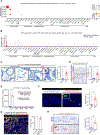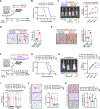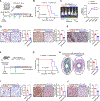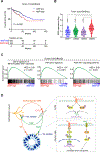Neuro-Mesenchymal Interaction Mediated by a β2-Adrenergic Nerve Growth Factor Feedforward Loop Promotes Colorectal Cancer Progression
- PMID: 39137067
- PMCID: PMC11729495
- DOI: 10.1158/2159-8290.CD-24-0287
Neuro-Mesenchymal Interaction Mediated by a β2-Adrenergic Nerve Growth Factor Feedforward Loop Promotes Colorectal Cancer Progression
Abstract
Abstract: Cancer-associated fibroblasts (CAF) and nerves, components of the tumor microenvironment, have each been shown to directly promote gastrointestinal cancers. However, it remains unknown whether these cells interact with each other to regulate cancer progression. We found that in colorectal cancer, norepinephrine induces ADRB2 (β2-adrenergic receptor)–dependent nerve growth factor (NGF) secretion from CAFs, which in turn increases intratumor sympathetic innervation and norepinephrine accumulation. Adrenergic stimulation accelerates colorectal cancer growth through ADRA2A/Gi-mediated activation of Yes-associated protein (YAP). NGF from CAFs directly enhances colorectal cancer cell growth via the phosphatidylinositol-3-kinase/AKT pathway. Treatment with a tropomyosin receptor kinase (TRK) inhibitor decreased YAP and AKT activation and colorectal cancer progression in mice. In human colorectal cancer, high NGF expression is associated with mesenchymal-like tumor subtype and poor patient survival. These findings suggest a central role for reciprocal CAF–nerve cross-talk in promoting colorectal cancer progression. Blocking this feedforward loop with a TRK inhibitor may represent a potential therapeutic approach for colorectal cancer.
Significance: Our work demonstrates that the bidirectional interplay between sympathetic nerves and NGF-expressing CAFs drives colorectal tumorigenesis. This study also offers novel mechanistic insights into catecholamine action in colorectal cancer. Inhibiting the neuro-mesenchymal interaction by TRK blockade could be a potential strategy for treating colorectal cancer.
©2024 American Association for Cancer Research.
Conflict of interest statement
Disclosures:
The authors declare no potential conflicts of interest.
Figures







References
MeSH terms
Substances
Grants and funding
LinkOut - more resources
Full Text Sources
Medical
Molecular Biology Databases

